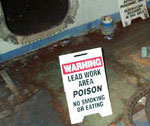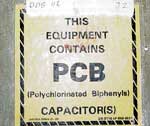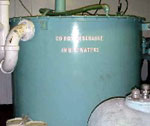Shipyard Employment eTool
Shipbreaking >> Inventory of Hazardous Materials

Scrapping vessels presents safety, health, and environmental hazards. Because hazardous materials are used in ship construction and repair and may be contained in fuel and cargo residues, vessels being scrapped present safety, health and environmental hazards. Prior to scrapping, it is recommended that an inventory of hazardous materials be taken. This inventory should identify all hazardous material on the vessel that should be removed or disposed of in order to protect workers and prevent fire. Examples of hazardous materials include:

- Flammable or combustible residues (fuel, hydraulic fluid, lube oil). See Figure 1.
- Cargo residues (coal, sulfur, corrosives, pesticides, and fumigants).
- Paints (containing Lead, Cadmium, PCBs). See Figure 2.
- Preservatives (tank coatings, Cosmoline).
- Asbestos (pipe insulation, bulkheads, wiring, tile, boilers). See Figure 3.
- Foam insulation (cyanide, toxic byproducts).
- Electrical equipment and wiring (PCBs, asbestos, lead-shielded cable). See Figure 4.
- Biological hazards (sewage tanks). See Figure 5.
- Radioactive materials (gauges and level indicators).
- Fire protection system (CO2, Halon, foam).

During shipbreaking, in addition to understanding the use of hazardous materials used in shipbuilding, repair and breaking; the following should be conducted to help determine the location of hazardous materials:

- Conduct bulk sampling (such as insulation, paints, and electrical equipment and wiring)
- Review vessels drawings (such as initial drawings and as-built drawings)
- Review ships logs (such as fuel, maintenance, cargo, and repair logs)

Note: EPA has additional environmental requirements that apply to shipbreaking. See the EPA Guide for Ship Scrappers.

